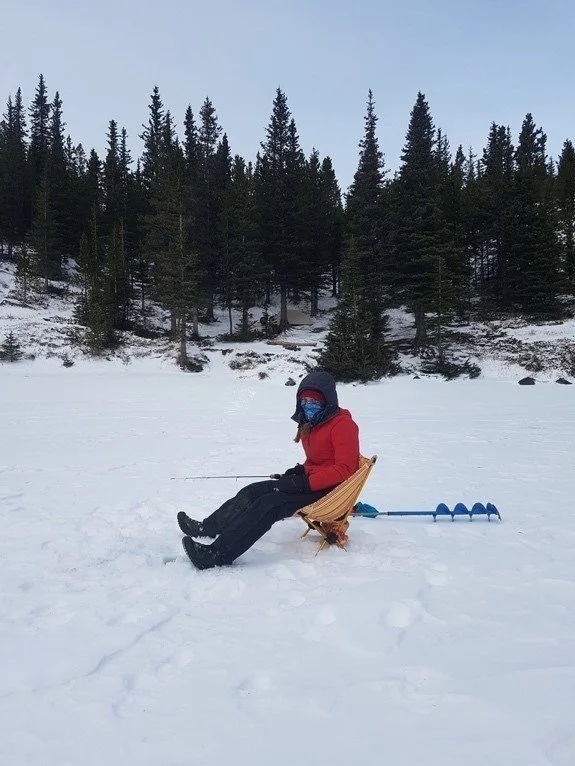BONEFISH! TWELVE O’CLOCK!
AJM’s Fisheries Biologist, Hillary Keyes, recounts her recent adventures in Belize!
The past few years in the month of March, you would have found me on a frozen Alberta lake with a tiny rod, jigging for any of our resident trout species or yellow perch, sometimes with a tip-up baited for northern pike nearby. It’s the last real month of ice fishing before the ice breaks away, opening creeks and rivers that weave down our Eastern Slopes, marking the beginning of spring fly fishing season.
Figure 1. Ice fishing in Alberta’s Eastern Slopes
This March, my husband Zach and I packed our hardwater gear away early in exchange for our fly rods, and reels spooled with saltwater line for our first trip to the tropics together. We had watched the YouTube videos, researched the best saltwater flies, and were ready to catch fish in the flats surrounding Ambergris Caye, Belize where we would spend the first week of our belated honeymoon. For two fisheries biologists, a honeymoon can look a lot like a fishing trip, but we vowed to spend time exploring other interests we share, like birding, adventure tours, and visiting Mayan cultural sites.
On our first afternoon on the island, Zach had already caught a fish – a bar jack (Caranx ruber) he casted to from a dock where I was photographing a friendly brown pelican. We watched needlefish (Family: belonidae) swim in the shallows trying their best to bite the “Crazy Charlie” on the end of my line, but their needle-shaped snouts prevented them from getting hooked, despite their best efforts. Each new species we saw was an exciting event – we couldn’t wait to meet our first bonefish!
Figure 2. Bonefish
Bonefish (Albula vulpes), named for the many fine bones the fish contains, were our target species during a day of guided flats fishing. A highly sought-after sportfish, and one-third of the “Grand Slam” – a feat of angling defined by the International Game Fish Association as the catching of bonefish, permit (Trachinotus falcatus), and tarpon (Megalops atlanticus) in a single day. Bonefish feed in the flats, poking around in the sand for crustaceans with their downturned mouths. Anglers can identify feeding areas by the muddy patches in otherwise crystal-clear water.
Our fishing guide picked us up from the dock at our hotel early in the morning and we climbed aboard. I quickly learned how difficult casting a streamer in windy conditions was for this novice saltwater angler, and by noon, neither of us had caught anything.
To our untrained eyes, the bonefish were difficult to identify. Even when our guide exclaimed “Bonefish! Twelve o’clock! Forty feet!” we just couldn’t spot them, despite our polarized glasses and determination. When bonefish are feeding, they can be easy to spot – you can see “the flash” – a reflection of the sun on the side of their silver bodies as they forage in the sand. We didn’t see much of this, though, and the guide explained they were not actively feeding that day. We noticed fish hanging out in the flats, but when they aren’t feeding, they are more alert; their vision isn’t compromised by the underwater sand clouds their feeding habits create, making it more difficult to tow a streamer in front of their face without spooking them into the next bay. Actively feeding, they are less aware and that cloud of sand causes them to be less apt to be spooked by a copy-cat shrimp floating past – and more likely to take a bite at it.
Figure 3. Wading the flats in search of bonefish with our guide.
We left the boat and waded the flats for a while, the guide at my side while Zach, the more experienced angler, fished on his own in the same bay, where he caught the first, and what would be the only, bonefish of the day. I was excited for him, and a little jealous. Bonefish fight extremely hard for their size and are fun to bring in. By the end of the day, we were getting better at seeing them and had a few more shots, but the biting turns off at around two in the afternoon. We stayed out until three and casted at a school of surfacing permit and a few more bonefish. Wind burned and humbled, we returned to our hotel to ponder how badly we had been schooled.
In the following days, we pursued these elusive fish on our own, finding what we thought would be likely spots to catch them based on Google satellite imagery of the shoreline. On our last day before heading inland for the second week of our trip, we used the paddleboards from our hotel to paddle out into the ocean and towards what looked to be potentially good habitat to stalk our prey. We weaved through mangroves where where we had previously seen a few bonefish, before coming to a sheltered bay where we would begin the hunt. After a couple hours of fruitless casting, I opted to check out a spot sheltered by mangroves where I had seen smaller fish schooling, a species unknown to me.
Figure 4. Barracuda
Almost immediately, I started catching these small, yellowish panfish. It was a thrill to finally have something on the end of my line after putting so much effort into bonefish with no return. In about an hour, I had caught close to twenty fish which I later identified as schoolmaster (Lutjanus apodus), mutton snapper (Lutjanus analis), and bar jack. These critters were easy to catch, and I had a blast watching them follow my fly and eventually bite as I stripped my line in. I now regret that I didn’t take photos of them, but my fear of dropping my phone in the ocean while fishing off a paddleboard outweighed my desire for a fish pic. Zach was still out in the open flats in pursuit of more bonefish, but there were none to be found. The schooling mullet (Mugil curema) and great barracudas (Sphyraena barracuda) can look like bonefish at first glance. The barracudas, we learned through experience, are notorious for breaking line and stealing your fly with their sharp teeth.
Figure 5. A jumping tarpon
By this point, we were both intimately familiar with missing flies and snapped lines. At a lagoon near our hotel where we stopped to observe the storks, ibises, herons, and plovers wading in the shallow water, or roosting above the mangroves, we heard a splash! Across the road in a partially cleared mangrove lagoon, tarpon were feeding. Never missing an opportunity to get to know a new fish, we got our rods and casted into these warm backwaters. Tarpon are known to jump like crazy when caught, and we were lucky to have this experience before the line snapped. Here, the tarpon were about a foot in length, but adults can be massive, reaching up to 8 feet long and 350 pounds. We visited the “tarpon hole” several times before leaving the island, armed with heavier line and hand-tied tarpon flies that a friendly American gave us, but they didn’t bite.
Beyond its fame as a fishing destination, Belize is known for its world-class diving, particularly in the Belize Barrier Reef Reserve System. Inscribed as a UNESCO World Heritage Site, it is the second largest reef system in the world, runner up only to the Great Barrier Reef off the coast of Australia. We snorkeled in the Hol Chan Marine Reserve, established in 1987 for the protection of important coral reef, seagrass, and mangrove habitats. Darting in and out of these diverse underwater structures were blue striped grunt (Haemulon sp), green moray eel (Gymnothorax funebris), horse-eyed jacks (Caranx latus), permit, rainbow parrotfish (Scarus guacamaia), green turtles (Chelonia mydas), nurse sharks (Ginglymostoma cirratum), southern stingrays (Hypanus americanus), and countless other lifeforms we had never seen before.
Figure 9. The inland blue hole
Fishing was not our focus as we traveled to Belize’s mainland, but we wanted to know more from the local guides and about their experiences with freshwater fish. Spearfishing is a common catch method for subsistence fishing among locals, who target tilapia (Tilapia spp.) and other cichlid species. We noticed some of these small cichlids with large scales swimming beside us in the inland blue hole, part of an underground river that surfaces for a short distance before flowing into a cave and underground again. While touring the Actun Tunichil Muknal Caves archaeological site, we spotted a small Mayan catfish (Ariopsis assimilis) in my headlamp light while navigating the underground river cave system.
Surrounding Belize, the saltwater, freshwater, and brackish areas in between are host to a truly amazing diversity of marine and terrestrial life. A person cannot hope to learn it all in just two weeks, but what we did learn of the habits and life histories of these species so exotic and unfamiliar to us was fascinating. Fishing for them was equal parts challenging and rewarding, and we are looking forward to our next adventure in the realm of saltwater fishing. Until then, I will be streamside in Alberta or BC: collecting water samples, recommending native trout habitat restoration measures, or assessing barriers to their upstream migration.
References:
Florida Museum (Discover Fishes – Florida Museum of Natural History (ufl.edu))
All photos by Hillary Keyes or Zach Spence









